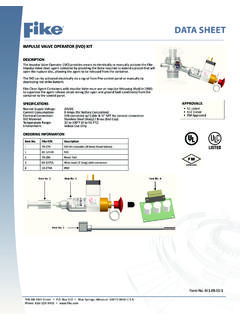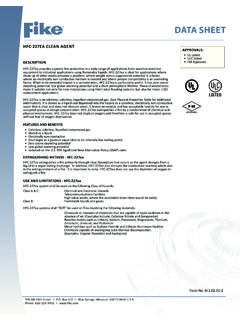Transcription of TECHNICAL TIN - Fike
1 TECHNICAL BULLETINForm No. TB8100-2 704 SW 10th Street Box 610 Blue Springs, Missouri 64013-0610 Phone: 816 229 3405 CODE AND RUPTURE DISCSASME CODE CONCERNING RUPTURE DISC DEVICESR upture disc devices are addressed in several areas within the family of ASME Codes and Standards. The following is a listing of the most generally relevant references regarding requirements for rupture disc devices. ASME Section VIII Division 1 UG125-UG137 ASME BPE - ASME Section VIII Division 2 Part AR ASME Section III Division 1, Subsection NB, NB-7000 ASME Section VIII Division 3 Part KR ASME Section III Division 1, Subsection NC, NC-7000 ASME Section I Part PVG ASME Section III Division 1, Subsection ND, ND-7000 Except where noted this document will address the specific requirements of ASME Section VIII, Division 1 (ASME Code).
2 Many of the requirements are fundamentally the same throughout each of the sections however there are differences with regard to sizing, certification, and marking, mostly stemming from the 1998 change in Section VIII, Division 1 when UD certification and flow resistance testing were incorporated. ASME CODE RUPTURE DISC TERMINOLOGY A rupture disc device is a non-reclosing pressure relief device actuated by inlet static pressure and designed to function by the bursting of a pressure containing disc. A rupture disc is the pressure containing and pressure sensitive element of a rupture disc device. A rupture disc holder is the structure which encloses and clamps the rupture disc in position. The manufacturing design range is a range of pressure within which the marked burst pressure must fall to be acceptable for a particular requirement as agreed upon between the rupture disc manufacturer and the user or his agent.
3 The specified disc temperature supplied to the rupture disc manufacturer shall be the temperature of the disc when the disc is expected to burst. A lot of rupture discs is those discs manufactured of a material at the same time, of the same size, thickness, type, heat, and manufacturing process including heat treatment. The minimum net flow area (MNFA) is the calculated net area after a complete burst of the disc with appropriate allowance for any structural members which may reduce the net flow area through the rupture disc device. The net flow area for sizing purposes shall not exceed the nominal pipe size area of the rupture disc device. The certified flow resistance factor (KR) is a dimensionless factor used to calculate the velocity head loss that results from the presence of a rupture disc device in a pressure relief DISC PERFORMANCE REQUIREMENTSThe ASME Code provides requirements for rupture disc performance and does not have provisions for tolerances greater than indicated.
4 The burst pressure tolerance at the specified disc temperature shall not exceed 2 PSIG for marked pressures up to and including 40 PSIG and 5% for marked burst pressures above 40 PSIG. The rupture disc must be marked at a pressure within the manufacturing design discs are typically manufactured to order where each order represents a lot. The ASME Code defines 3 methods of acceptance testing for rupture discs. The most common method requires that at least two discs from the lot be burst tested at the specified disc temperature. The results of these tests must fall within the rupture DISC SIZING METHODOLOGIESThe ASME Code defines three methodologies for sizing rupture disc devices. Details on sizing methods can be found in TECHNICAL bulletin coefficient of discharge method (KD) uses the calculated flow capacity of the device based on the minimum net flow area (MNFA) and then de-rates that capacity by a KD of This method is applicable only under the following conditions: The disc discharges to atmosphere The disc must be installed within 8 pipe diameters of the vessel nozzle The length of discharge piping must not exceed 5 pipe diameters The nominal diameters of the inlet and outlet lines are equal to or greater than the nominal diameter of the device.
5 This sizing method incorporates not only the rupture disc device but also takes into account the vessel nozzle, inlet piping, and exit piping for a simple system within the constraints resistance to flow method (KR) has been adopted by the ASME Code for sizing relief systems when other methods do not apply. The rupture disc is treated as just another piping component within the relief system. The resistance of the rupture disc is denoted by a KR valve established by test during the certification process. The ASME Code requires that the calculated relieving capacity of the system be multiplied by to allow for uncertainties inherent in this method. 2 of 3 Due to the variation in the opening characteristics of many rupture disc types between compressible and incompressible media the flow resistance for a given rupture disc is given as a KRG (for gas), KRL (for liquid), and/or KRGL (for gas or liquid).
6 Since the opening, and subsequently the flow resistance, is primarily determined by the initial opening characteristics, it is recommended that the KR value be selected based on the state of the media directly in contact with the rupture disc at the time of rupture. A listing of fike KR values can be found in combination capacity method is applicable when a rupture disc device is used upstream of a pressure relief valve (PRV) in conjunction with the requirements as noted below. The PRV is sized using normal sizing procedures and then the capacity of the valve is de-rated by the default combination capacity factor of The rupture disc size must be equal to or greater than the nominal pipe size of the PRV to the default combination capacity factor, a certified combination capacity factor can be established by testing specific rupture disc / pressure relief valve combinations and registering these test results with the National Board of Boiler and Pressure Vessel Inspectors (National Board).
7 A listing of fike certified combination factors can be found in TECHNICAL bulletin CERTIFICATION The ASME Code has provisions for the application of the UD Code symbol to rupture disc devices. The authorization to use the UD stamp is based on an audit by the ASME designee (National Board) of various manufacturing, testing, and quality assurance systems. This audit is repeated at a minimum of every 3 years to insure ongoing compliance. RUPTURE DISC DEVICE CERTIFICATIONIn order to apply the UD symbol, the rupture disc device family must successfully complete: Flow resistance certification tests using either; the default KR value of 1 size method 3 size method Demonstration of manufacturing, testing, and quality control processes of representative production discs, witnessed by the ASME designee (National Board).
8 This demonstration is repeated every 5 years for each product family 1 size method consists of bursting and flow testing 3 pieces of 1 size of a device design at the minimum burst pressure for that size. This results in a certified KR value that can be used for that size only and for pressures equal to or greater than the tested pressure. The 3 size method requires bursting 3 discs from 3 different sizes within a product family as the minimum burst pressure for each size. The resulting KR value can be used for all sizes and pressures of the product family, however for the tested sizes the burst pressure must be equal to or greater than the tested pressures. Certified KR value cannot be less than the average flow resistance plus 3 times the average of the absolute values of the deviations of individual flow resistances from the average flow resistance.
9 RUPTURE DISC MARKING REQUIREMENTSThe ASME Code defines the minimum requirements for marking of rupture disc devices. The following information is marked on the rupture disc tag for discs certified to the 1997 Addenda or later versions of the ASME Code. Manufacturer s Name Model or Part Number Lot Number Disc Material Nominal Size Marked Burst Pressure Specified Disc Temperature Minimum Net Flow Area Certified Flow Resistance KRG, and/or KRL, and/or KRGL Year Built (or code) ASME UD SymbolThe following information is marked on the holder tag. Manufacturer s Name Model or Part Number Size Flow Direction Year Built (or code) ASME UD SymbolASME APPLICATION REQUIREMENTS The ASME Code defines certain sizing and pressure rating criteria for various applications of rupture discs.
10 In the case of primary relief or sole relieving device (shown in figure 1), it must be sized to prevent the pressure in the vessel from rising more than 10% or 3 PSIG, whichever is greater, above the maximum allowable working pressure (MAWP). In addition, the rupture disc marked burst pressure shall not exceed the ASME Code allows rupture disc devices to be used in multiples or as a secondary device to other rupture disc devices or pressure relief valves (shown in figure 2). In this case, the secondary device is sized to prevent the pressure in the vessel from rising more than 16% or 4 PSIG, whichever is greater, above the MAWP. The burst pressure of the secondary device may be marked at a pressure not exceeding 105% of the ReliefFigure 1 Primary Secondary ReliefFigure 2 Secondary3 of 3 Another application allowed by the ASME Code is the use of a rupture disc in combination with a pressure relief valve (shown in figure 3).






